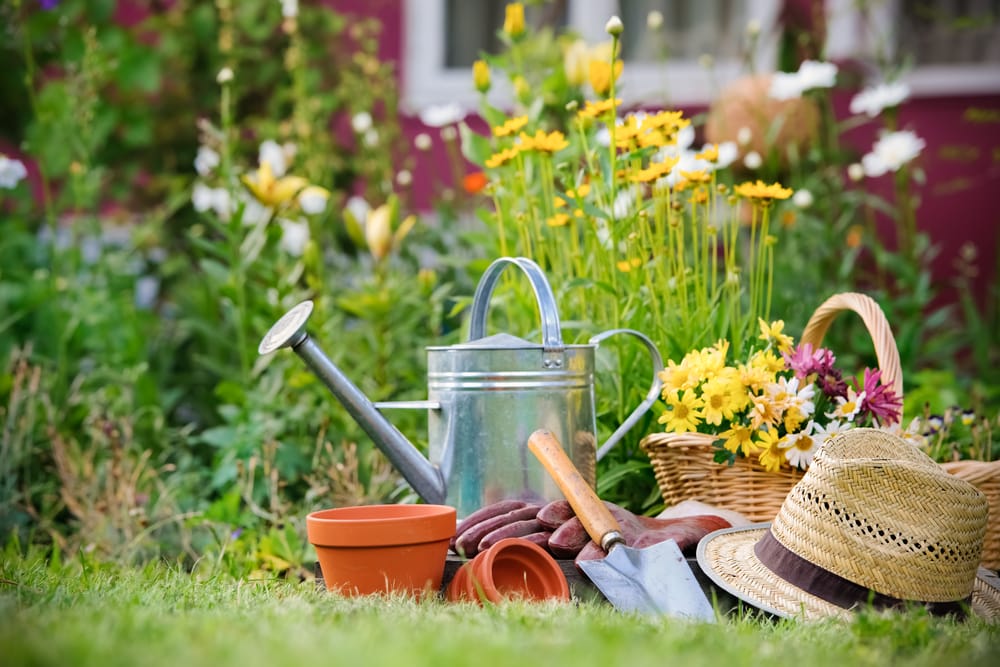On the hunt for spring gardening tips? Look no further!
It’s spring, which means it’s the perfect time of year for planting just about anything! The moisture in the soil is still high from the winter rainfall and plants still have enough time to become established in a new home before the heat sets in. It’s time to assess the health of your garden after a chilly winter and swoop in to repair and nurture it where it’s needed. We’ve compiled some essential tips to help with your spring gardening.
1. Restore Lawn & Order
If yellowing grass or bare patches in your lawn thanks to the family dog have been ruining your garden view over winter, now is the time to clean up your lawn and make it a lush carpet of green once again. The first step is to take a garden fork and use it to aerate the lawn. This allows air, water and nutrients to reach the grass roots, helping them to grow deeper and produce stronger grass.
In early spring, apply a weed killer then follow up in a few weeks’ time with a fertiliser. This will ensure that only the good parts of the lawn grow, rather than the weeds. Finally, don’t forget to plant lawn seed in the bare patches before it gets too hot.
2. Start Pruning Now
Spring is a great time for pruning because the conditions are perfect for recovery, which means your plants will bounce back quickly. From fruit trees to hedges to summer blooming trees to camellias and other winter flowering plants, it’s time to start pruning.
3. Don’t Hold Back on the Planting
The soil in your garden is more hospitable than ever in spring, so if there are gaps in your garden that you want to plant something into, now is the time to do it. It’s also important to give some TLC to the plants already living in your garden. Renew your mulch cover so your plants can prepare themselves for a dry summer by storing moisture more effectively. By mulching in spring you will also prevent weeds from sprouting, which will make your gardening maintenance a lot easier come summer. For more information on what to plant, check out our Spring planting guide.
4. Re-Potting Should be a Priority
While you’re at it, consider whether your potted plants have become overgrown or used up most of the nutrients in their pots. Re-pot plants that have done a lot of growing into larger containers to give them much-needed room. If a plant has been living in the same pot for over a year, it’s a good idea to upgrade them to a new pot with fresh potting mix too, as potting mix can become tired and spent after a significant period of time.
5. Feed the Beast
After winter, your whole garden will be hungry. Make sure to feed everything including fruit trees, roses, gardenias, hibiscus and veggies. Ideally, your garden was thoroughly fertilised in autumn too so the plants had enough energy to keep them going throughout winter. That way the fertilising you do in spring acts simply as a pick-me-up to help at the other end. If you find some of your plants are looking worse-for-wear after winter, it may have been because they were not equipped with enough food to get them through the colder months. Feeding these plants in spring won’t be a silver bullet that will make them healthy overnight, but it will help them begin to recover.
6. Tend to Your Veggie Patch
The warmer weather means new fruits and vegetables are now in season again, such as tomatoes, carrots, potatoes and spring onions. Revitalise your soil by digging compost and manure through your veggie patch so you’re ready to plant. For veggies that you’ve already planted, be sure to dose them with a liquid fertiliser which they can absorb quickly. Keep liquid fertilising your summer veggies on a fortnightly basis to make it as easy as possible for them to grow into big and healthy crops in summer.
7. Late Spring Tricks
Looking ahead to the end of spring, don’t forget these final preparations to make your garden well and truly ready for the summer. First of all, it’s important to deadhead your spring-flowering bulbs. When you don’t remove yellow and dried up blossoms yourself, you allow the plant to use its energy to make seeds. Instead, cut off the seed-spreading process by deadheading spent bulbs and encouraging the plant to store its energy for next year instead.
Finally, before spring ends, go out and shop for summer annuals and get them in the ground soon so they can bring colour to your garden throughout the new year.
8. Prevent Pests Now
More often than not prevention is the best cure and your garden is no exception. Along with warmer weather come aphids, psyllids and other pests, which make a home on your veggies and new growth of roses and other plants. Use a garden insecticide in the spring to prevent the spread of any unnecessary visitors to your garden and maintain a healthy garden.
With these spring gardening tips complete, your yard will thank you by looking gorgeous all summer.





